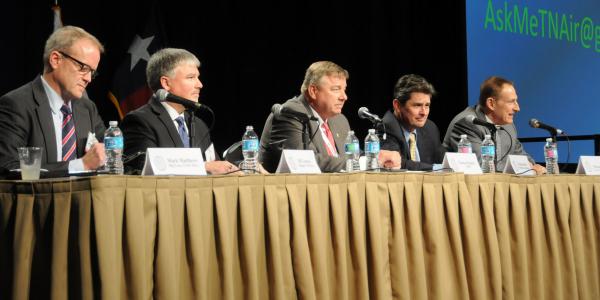Next-Gen Airframe Spelled BLIMP
History repeats itself: And the next-generation airframe might come as a bit of a surprise.
Blimps.
“They’re back,” said Thomas Kupiec, chief information security officer for SMS, as he shared as an example of two prototypes NASA is working on, complete with bulletproof skin and the potential for unmanned flight in the future.
But what is greatly different today from the first blimps of the 1890s is the need for cybersecurity, Kupiec shared during an afternoon panel discussion at AFCEA International’s inaugural TechNet Air 2016 symposium in San Antonio, which runs March 22-24.
“Technology is changing so fast … that it’s changing everything around us,” he continued. For example, it has altered how we socially interact with others, and how quickly companies compete with one another to get the next great cellphone to market. It has impacted politics and how candidates campaign, and technology has even contributed to successful recruiting efforts that has led to the rise of radical Muslims, he said.
So obviously, the military is no different in either its dependence on technology or the vulnerabilities it introduces.
So much of the technological developments operate somewhere in cyberspace, which is becoming increasingly congested and contested, experts said.
“There is no nation on Earth that would challenge our air superiority in an air battle,” offered panel moderator Lt. Gen. Michael Basla, USAF (Ret.). The same, however, cannot be said for the cyber domain, as adversaries are on the prowl for “ways to get at our underbelly.”
Many of the U.S. military modern airframes are being retrofitted to deal with the cyberthreats introduced by a world in which everything is connected. “It’s not just the pervasive threats we see everyday, with attacks on Sony and the banks—it’s the trends of technology and the ever increasing reliance on software defined systems” that has some experts worried, shared Tom Jones, sector vice president and general manager of the Advanced Concepts and Technologies Division of Northrop Grumman Mission Systems.
Prediction methodologies for cyberthreats has also gone through some changes. Security experts have started asking when networks might be attacked, rather than if they would be attacked. Another change is afoot, with experts now asking, “When am I going to discover” the attack, making dwell time a great concern, warned Bill Lemons, director of systems engineering for the federal government sector of Juniper Networks.
Disruptive cybersecurity will revolve around flexibility of solutions and how rapidly they can adapt to changing threats, Lemons offered. “We need to build flexibility in the architecture to allow for change. There’s no reason why devices have to have static addresses,” he said.
Moving to the military arena from industry, cyber must be considered now as an offensive weapon and operationalized in order to be most effective, offered Maj. Gen. Mark Matthews, USAF (Ret.). “Operational commanders, who are already offensively minded, haven’t truly embraced” cyber as an effective offensive tool, he said, calling for more training in the arena.
A movement to changing that mindset reminds Gen. Matthews of an old military adage, he said. “You fight the way you train.”
History—and mantras—repeat.






Comment
Interesting!
Compelling presentation!
Comments